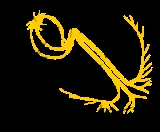
Electrical conduction system of the heart
Overview
The normal intrinsic electrical conduction of the heart
allows electrical propagation to be transmitted from the Sinoatrial Node
through both atria and forward to the Atrioventricular Node
. Normal/baseline physiology allows further propagation from the AV node to the ventricle
or Purkinje Fibers
and respective bundle branches and subdivisions/fascicles. Both the SA and AV nodes stimulate the Myocardium. Time ordered stimulation of the myocardium allows efficient contraction of all four chambers of the heart, thereby allowing selective blood
perfusion through both the lungs and systemic circulation.
Cardiac neurons innervating the myocardium bear limited similarities to those of skeletal muscle as well as other important differences.
Heart
The heart is a myogenic muscular organ found in all animals with a circulatory system , that is responsible for pumping blood throughout the blood vessels by repeated, rhythmic contractions...
allows electrical propagation to be transmitted from the Sinoatrial Node
Sinoatrial node
The sinoatrial node is the impulse-generating tissue located in the right atrium of the heart, and thus the generator of normal sinus rhythm. It is a group of cells positioned on the wall of the right atrium, near the entrance of the superior vena cava...
through both atria and forward to the Atrioventricular Node
Atrioventricular node
The atrioventricular node is a part of the electrical control system of the heart that coordinates heart rate. It electrically connects atrial and ventricular chambers...
. Normal/baseline physiology allows further propagation from the AV node to the ventricle
Ventricle (heart)
In the heart, a ventricle is one of two large chambers that collect and expel blood received from an atrium towards the peripheral beds within the body and lungs. The Atria primes the Pump...
or Purkinje Fibers
Purkinje fibers
For the nervous cells, see Purkinje cellPurkinje fibers are located in the inner ventricular walls of the heart, just beneath the endocardium...
and respective bundle branches and subdivisions/fascicles. Both the SA and AV nodes stimulate the Myocardium. Time ordered stimulation of the myocardium allows efficient contraction of all four chambers of the heart, thereby allowing selective blood
Blood
Blood is a specialized bodily fluid in animals that delivers necessary substances such as nutrients and oxygen to the cells and transports metabolic waste products away from those same cells....
perfusion through both the lungs and systemic circulation.
Cardiac neurons innervating the myocardium bear limited similarities to those of skeletal muscle as well as other important differences.
Unanswered Questions
Discussions

